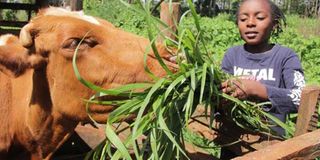How to feed a lactating cow

A lactating cow should be offered a balanced ration that meets its nutritional requirements. FILE PHOTO | JOSEPH KANYI |
What you need to know:
- The productivity of dairy animals is to a large extent dependent on how well they are fed.
- Dairy cows are highly sensitive to changes in feeding and production can fall dramatically with small variations.
QUESTION: I feed my Friesian cow what I consider to be the right quality and quantity of feeds, yet it doesn’t produce the amount of milk I was told when I was buying it. What could the problem be?
Nelly, Narok
The productivity of dairy animals is to a large extent dependent on how well they are fed.
Dairy cows are highly sensitive to changes in feeding and production can fall dramatically with small variations.
A farmer should set a good feeding schedule and as much as possible adhere to it.
THE LACTATION PHASES
The lactation period is divided into four phases based on the cow’s physiological cycle and nutrient requirements. Feeding should be based on these phases:
Phase one
This phase is from calving to peak milk production at 70 days after calving. Milk production increases rapidly during this period peaking at six to eight weeks.
The cow should be well-fed to achieve high milk production by increasing concentrates by about 0.5kg per day to a maximum of 50 to 60 per cent diet dry matter after calving.
This will increase nutrient intake while minimising off-feed problems like lack of appetite and acidosis (rumen acids increase which stops normal function and digestion).
Phase two
This phase is between 70 to 140 days after calving. The main aim of feeding the cow is to maintain its peak production as long as possible.
Forage quality should be high with intake of at least 1.5 per cent of the cow’s body weight (dry matter basis) per day to maintain rumen function and normal fat test.
Phase three
This phase is between mid and late lactation, that is, 140 to 305 days after calving. It is the easiest period to manage in a dairy cow’s cycle.
The cow should be offered a balanced ration that meets the nutrient requirements. These nutrients include energy, proteins, fibre, vitamin and minerals.
Body condition of cows and heifers should be evaluated regularly so that feeding and management practices can be appropriately altered.
Excessive body fat before calving should be avoided since it is associated with increased metabolic diseases and calving problems.
Phase four
This is the dry period (non-lactating) which ideally begins 45 to 60 days prior to the next calving. The dry period allows the cow to prepare for the next lactation.
This process takes three to four weeks. Cows which are given a dry period of less than 30 days will produce less milk in the subsequent lactation.
A minimum dry period of 55 to 60 days is recommended. A dry period of more than 70 days can contribute to obesity at calving. Obese cows are more likely to have calving difficulties.
In conclusion, we assert that the right quality and quantity of feed concentrates (supplements), dry matter (pastures, silages and hays), minerals and water are important for optimal milk production.
Mr Mazao, Unga Farm Care Limited
Do you have any questions on dairy animal feeds? Send to [email protected]. Our team of experts from Unga Farm Care Limited will answer all your queries.




